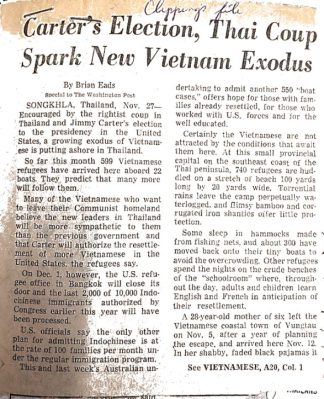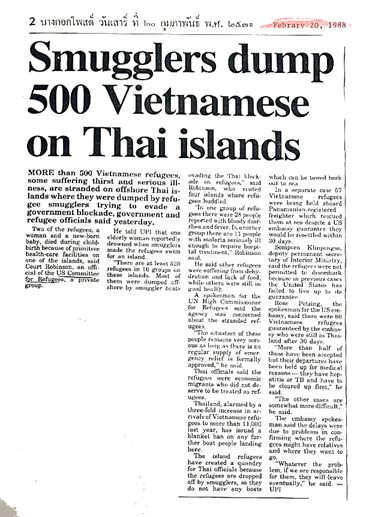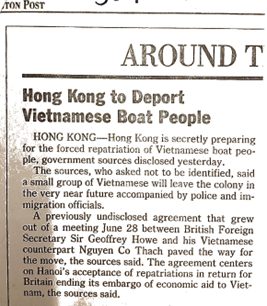Spotlight on Research: Guest author Ann Ngoc Tran was awarded the Grant-in-Aid Award at the Immigration History Research Center Archives (IHRCA). She visited Andersen Library for five days to study the topic of Vietnamese refugees in the U.S. Gulf South and the (re)making of life in the aftermath of war and violence. Ann is a PhD student in the American Studies and Ethnicity Department at the University of Southern California.
As a Vietnamese American scholar working on the cultural history of boat refugees, I have always known about what historians and sociologists call the “three waves” of refugee migration.
In this theory, the first wave exited the fallen state of South Vietnam in 1975 via U.S. airlift, flying first to military bases hastily constructed in Guam, Wake Island, and the Philippines before arriving in temporary reception centers located at Fort Chaffee, Arkansas; Pendleton, California; Eglin Air Force Base, Florida; and Fort Indiantown Gap, Pennsylvania.
The veritable second wave, remembered through the indiscriminate masses of “the boat people,” began in 1978 at the start of the Sino-Vietnamese War, when thousands of ethnic Chinese Vietnamese escaped the country by boat to evade persecution, and hundreds of thousands of Vietnamese rode the mercurial seas to crowded refugee camps across Southeast Asia in search of economic and political respite.
This second wave, sandwiched between 1978 and the mid-1980s, transitioned to the third wave with the passage of the American Homecoming Act of 1988, which brought Amerasians to U.S. shores; the joint Humanitarian Operation program in 1989 that allowed former reeducation camp prisoners to immigrate overseas; and the Orderly Departure Program, which permitted nearly 500,000 Vietnamese to come to North America.
I had read, studied, and digested so many stories about these three waves of refugees that when I sat down in the Elmer L. Andersen Library Reading Room to find archival materials on the Vietnamese boat refugee dilemma, specific to the so-called second wave, I was unsettled by the inconstancy of movement that belied anything I had ever known about refugee migration, which I formerly accepted — even naturalized — as ultimately ending on United States soil (a limitation, I am fully aware, of being an American Studies scholar).
Here, there were so many stories, statements, and blurbs that gestured to other realities, other waves within a singular “second” wave: people who chose to return voluntarily, were deported, crossed the oceans again and again due to capture, traveled from one camp to another, or resigned to stay behind.
Poring over the newspaper clippings and files of the Refugee Studies Center records and the United States Committee for Refugees and Immigrants records — all available in the Immigration History Research Center Archives (IHRCA) — my fingers traced itinerant movements that veered off from the courses of travel I was familiar with, like tiny limbs jutting off from the main branches of a deeply rooted tree.
“Nothing is known about the 1,500 refugees who returned to Saigon of their own free will aboard a refugee ship last fall—except the difficult-to-confirm report that one among them, a former Saigon Navy lieutenant by the name of Vu Tien Hai, was executed shortly after the ship landed at Saigon on charges of being a spy,” wrote journalist Bang Phi Nguyen in 1976 in the Christian Science Monitor (IHRC2640, Box 3, Folder 1).

Newspaper clipping, courtesy of the United States Committee for Refugees and Immigrants Records, IHRCA, Box 3.
“Nobody has kept records of those who made it, those who drowned or those still wandering at sea, sometimes for months, vainly looking for a friendly port. Some have been turned back by Vietnamese patrol boats. Others have been arrested at the water’s edge or trapped by police agents who set up fake escape plots,” wrote George McArthur for the Los Angeles Times in 1976 (IHRC2640 Box 3, Folder 2).
People had been leaving Vietnam on boats since January of 1976, long before the peak of the boat departures that matched the splashy news headlining the world in 1978 and 1979 and the temporal markers of what we know as the “second wave.”
Another discovery: Vietnamese boat movements were not only dictated by internal political issues but also by other countries’ changing regimes.
“Encouraged by the rightist coup in Thailand and Jimmy Carter’s election to the presidency in the United States, a growing exodus of Vietnamese is putting ashore in Thailand,” stated Brian Eads in a special to the Washington Post in November of 1976.
People were watching, scheming, waiting to leave. Where do we draw the line between voluntary and forced departures when we recount refugee escapes? Can it be both?

Thai newspaper clipping, courtesy of the United States Committee for Refugees and Immigrants Records, IHRCA, Box 157.
Other parties also stepped in—smugglers.
“The island refugees have created a [quandary] for Thai officials because the refugees are dropped off by smugglers, so they do not have any boats that can be towed back to sea,” an article from a Thai newspaper from 1988 reported.
I had never known there were smugglers involved when I read about boat refugees before. Was this a common phenomenon? Another question I didn’t know the answer to … yet.
I didn’t expect to find these narratives in an institutional archive so full of resettlement stories and government records advocating for the very linearity I failed, or refused, to see: the rescuing and resettling of refugees in the United States, especially in Minnesota and the Midwest.
Even within these folders, which were divided between successful assimilation stories and unsuccessful ones, there were glimpses of unsettlement that lingered even after refugees found their coveted haven. Some causes included family separation — which often left refugees in prolonged periods of anxiety — disabilities, and lasting depression, the latter encapsulated in an emotional statement by a Vietnamese labor leader:
“He lost his country. He lost the chance to return. That kind of sorrow will be lasting forever. It [sic] has to be a refugee to understand the sorrow of it. You can’t define it. But it’s there. He probably will not see his homeland any more. So many of his friends are left there. You have to be in the shoes of the refugee.” (International Institute of Minnesota Records, Box 101, Folder 4).

A case of deportation but not resettlement, courtesy of the United States Committee for Refugees and Immigrants Records, IHRCA, Box 23.
After spending time at the IHRCA, I realized that the materials I found pushed against what had simply become ingrained in the historical narrative of Vietnamese America: an assimilationist, almost uninterrupted path “from refugee to resettlement.”
Sure, there are estimates from the United Nations High Commissioner for Refugees about the dead at sea, but narratives of death were few and far between, suggesting both a hollow silence and deafening neglect of the journeys of those who never made it.
While the stories of resettlement are indeed valid and important, they should not come to stand in for the entire history, for Vietnamese American history isn’t just about the ones who have made it, but also about the ones who didn’t.
My own family’s stories detract from the easily linear historical narrative, just as do those I read in the archives. My uncle escaped Vietnam several times, yet his boat kept drifting back to Vietnamese shores, rendering him unable to cast away for other countries. Another relative found temporary asylum in Terengganu, Malaysia, only to be deported back home after two unsuccessful tries to find secure passage to the West. Both “boat people,” their narratives do not fit a narrative of progression from boat refugee to refuge or Vietnam to America. And neither should the history that is told about them.




